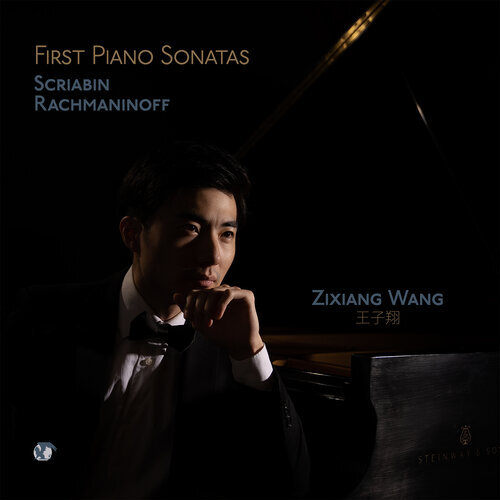Scriabin/Rachmaninoff: First Piano Sonatas
Recording: ****/****
Performance: ****/****
By Steven A. Kennedy
Pianist Zixiang Wang’s debut release provides an opportunity to explore two different approaches to the piano sonata by two of Russian composers at different stages of their careers. The music of Alexander Scriabin (1872-1915) is perhaps less known here in the US. His sensual orchestral music is a bit of that Symbolist-Impresssionist style from a distinct Russian perspective building on Wagnerian ultrachromaticism. His first sonata (1892) was written earlier in his career and delineates his own personal struggle with damage to his right hand from excessive practicing! Rachmaninoff’s music has tended to maintain itself well in the public concert hall though his solo piano music tends to demand great facility and virtuosic demands on the performer. Written in 1907, his first piano sonata was written during the composer’s more mature period—a time that also saw completion of the second symphony. Both pieces are still fairly rare, or at the very least, bear fewer overall current available recordings than other works in their oeuvre.
Scriabin’s sonata kicks things off with its grand romantic pianistic gestures in the opening “Allegro con focoso”. In this four-movement work, we can hear more Chopinesque writing in a piece that can feel like we are sitting in a grand salon. The music fits more into that traditional style of the period without some of the more outlandish chromatic writing Scriabin would later explore. In that sense, the sonata is a bit of a departure point to hear his early style as it would then evolve. The first movement structure is intriguing structurally, a hint at the composer’s experimental nature. The second movement is a bt more spiritual in focus with a choral-like quality. After a virtuosic display in the third-movement scherzo, we head into the funereal final movement, marked “Funebro”. The march, with its echoes to Chopin, is perhaps the composer’s acknowledgment of the death of his own concert career.
The music of Liszt finds its natural connection to Rachmaninoff’s first piano sonata both in its inception and inspiration—supposedly the underlying connection is a musical essay on Faust. A three-movement work with towering outer allegros to frame a romantic rumination on Gretchen, the sonata is an equally demanding virtuoso accomplishment. The outer movements feature references to the “Dies Irae” plainchant that haunted so much of Rachmaninoff’s work. It becomes a subsidiary idea within expanded textures and often shocking dissonances in the surrounding material. The dramatic qualities are also important here and Wang manages to bring these out well.
As a bit of an encore, Wang has chosen a rarer prelude, the Prelude in F, which was reimagined for cello and piano and published as Op. 2, no. 1. The choice here fits with Wang’s interest in bringing to light less familiar repertoire in his concerts.
Wang’s performance are quite excellently handled here and his virtuosity is not to be questioned. He is able to shift gears well to help add more to the communicative quality of the music. The delicate passages in the Scriabin are quite moving. The Rachmaninoff allows for an even more admiration for his rapid passage work coupled with the gentle reposes.
Blue Griffin has captured the piano well in this studio recording. There is just enough ambience to allow the sustains to die off well. The piano sound itself is a bit bright and crisp which allows Wang’s passage work to shine. Just enough pedal to help add what is needed in the big moments can provide the proper blurring that aids the darker, or more dissonant moments. These are committed performances that bring a proper emotional balance to the music. Certainly this is a good place to start to explore these rarer works even with some fine complete surveys of the Scriabin currently available. For those who find the later Scriabin not to their liking, this will make a gentle introduction to his more traditionally romantic qualities. The Rachmaninoff is equally stunning and more programmatic than one might at first perceive. Both pieces sit well together on this release which is worth tracking down for those interested in Russian piano literature.

